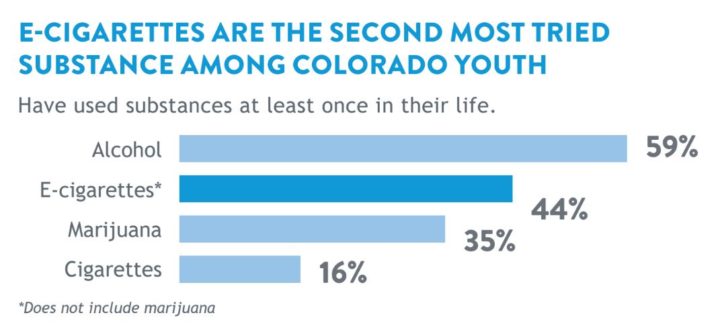Colorado Health Advisory: Youth Vape Use and Nicotine Addiction
The most recent Youth Risk Behavior Survey from the Centers for Disease Control and Prevention (CDC) shows that Colorado leads the nation in youth use of vapor products, known as vape or e-cigarettes.1
These products have become increasingly popular in recent years and are the second most used substance among Colorado high school students behind alcohol. One in four Colorado teens report that they vape.2
What our kids inhale from e-cigarettes and JUUL is not harmless water vapor.
JUUL is a new vaping device that looks like a flash drive and always contains nicotine in high dosages. Nicotine is the addictive substance found in vape and cigarettes. One small “pod” contains as much nicotine as a pack of cigarettes. JUUL has skyrocketed in popularity and is now estimated to be more than 70 percent of the US e-cigarette market.3

The vast majority of other vapor products sold in convenience stores also contain nicotine,4 even if the label doesn’t always say so. Nicotine, the addictive substance in vape and cigarettes, affects the developing brain. One in three Colorado high school students report using tobacco products and the vast majority of those vape.5
- Youth who vape are at risk for long-lasting effects of exposing their developing brains to nicotine. These risks include nicotine addiction, mood disorders and permanent lowering of impulse control.6 Nicotine also changes the way synapses (connections between brain cells) are formed, which can harm the parts of the brain that control attention and learning.7
- Teens who vape are more likely to start smoking cigarettes or cigars8, products that kill up to half of their users.
- Kids don’t realize vape products almost always contain nicotine.9 While nearly all teens know smoking cigarettes is unhealthy, fewer realize vape products are not good for their health.10
- Vapor products expose bystanders to air pollutants that are not safe to breathe. These can include cancer-causing chemicals, heavy metals and nicotine.11
Take action to address this emerging health issue
Parents:
- Talk with your kids about the risks of using e-cigarettes. Get our facts for your conversations.
- Set a smoke- and vapor-free rule for your home and car.
- Although vapor products may have the potential to benefit adult smokers who switch completely from cigarettes to vapor products, they are not safe for teens to use.12 Parents who choose to quit vaping or any other tobacco product can access free support through the Colorado QuitLine at 1-800-QUIT-NOW or coquitline.org.
Health Care Providers:
- Screen all youth, parents and caregivers for e-cigarette use and exposure.
- Counsel children and adolescents about the harms of e-cigarette use and clearly communicate the importance of never using e-cigarettes or other nicotine products.
- Refer youth to developmentally appropriate tobacco treatment, such as behavioral coaching offered through the Colorado QuitLine. The QuitLine serves clients age twelve and older.
- Review the American Academy of Pediatrics policy statement on e-cigarettes.
School Staff:
- Promote your tobacco-free policy to students, parents and staff and consistently enforce it.
- Use in-school alternatives to suspension such as Second Chance for youth who violate the policy.
- Encourage quitting among students and staff. We recommend Smokefree Teen at teen.smoke-free.gov or the Colorado QuitLine at www.coquitline.org or 1-800-QUIT NOW.
- Learn more about what schools can do to address this issue in this letter CDPHE recently sent to Colorado schools.
Policymakers:
- Require retailers to obtain an annual license to sell any tobacco product, including vape products. Suspend or revoke licenses for illegal sales to minors.
- Update the definition of tobacco products to include all nicotine products, including vape, to ensure these products are taxed and treated like other tobacco products.
- Restrict the use of e-cigarettes in public places where cigarette and marijuana use is already prohibited.
- Require age verification for the delivery of internet and mail-order tobacco and nicotine products.